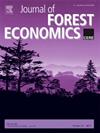Revisiting the Dynamics of Forest Area Change: A Panel Data Assessment
IF 0.7
4区 农林科学
Q3 ECONOMICS
引用次数: 1
Abstract
This study employs a panel dataset on forest area of 22 countries and for the time period 1995–2016 in order to provide an up-todate assessment on determinants of forest area change. Our set of explanatory variables is drawn from the Environmental Kuznets curve hypothesis and well-established factors affecting forest area change. In this respect, macroeconomic stability, socioeconomic development, institutional efficiency and quality of governance are taken into account to assess the cumulative nature of changes in forest cover. Using static and dynamic specifications our analysis produce different results with an inverted U-shape curve only in the static case and an inverted N-shape relationship in the dynamic specifications. Specifically, using an appropriate fixed effects model validates the EKC hypothesis finding an inverted U-shaped curve with high within-the-sample turning points. The random coefficients method applied does not support the EKC hypothesis in all possible specifications while the orthogonal deviations GMM estimates indicate the presence of an inverted U-shape relationship in all cases with lower cases within-the-sample turning points. A slow adjustment rate is found in all dynamic specifications indicating the need of around four time periods for a country to adjust to the LR equilibrium level of forest recovery.重新审视森林面积变化的动力学:一个面板数据评估
这项研究采用了一个关于22个国家森林面积的面板数据集,时间为1995年“2016年,为了对森林面积变化的决定因素进行最新评估。我们的一组解释变量来自环境库兹涅茨曲线假说和影响森林面积变化公认的因素。在这方面,我们考虑了宏观经济稳定、社会经济发展、制度效率和治理质量来评估森林面积变化森林覆盖变化的模拟性质。使用静态和动态规范,我们的分析产生了不同的结果,仅在静态情况下为倒U形曲线,而在动态规范中为倒N形关系。具体而言,使用适当的固定效应模型验证了EKC假设,发现样本转折点内的倒U形曲线很高。所应用的随机系数方法不支持所有可能规范中的EKC假设,而正交偏差GMM估计表明在样本转折点内具有较低情况的所有情况下都存在倒U形关系。在所有动态规范中都发现了缓慢的调整率,这表明一个国家需要大约四个时间段才能调整到森林恢复的LR平衡水平。
本文章由计算机程序翻译,如有差异,请以英文原文为准。
求助全文
约1分钟内获得全文
求助全文
来源期刊

Journal of Forest Economics
农林科学-林学
CiteScore
1.70
自引率
0.00%
发文量
16
审稿时长
>36 weeks
期刊介绍:
The journal covers all aspects of forest economics, and publishes scientific papers in subject areas such as the following:
forest management problems: economics of silviculture, forest regulation and operational activities, managerial economics;
forest industry analysis: economics of processing, industrial organization problems, demand and supply analysis, technological change, international trade of forest products;
multiple use of forests: valuation of non-market priced goods and services, cost-benefit analysis of environment and timber production, external effects of forestry and forest industry;
forest policy analysis: market and intervention failures, regulation of forest management, ownership, taxation;
land use and economic development: deforestation and land use problem, national resource accounting, contribution to national and regional income and employment.
forestry and climate change: using forestry to mitigate climate change, economic analysis of bioenergy, adaption of forestry to climate change.
 求助内容:
求助内容: 应助结果提醒方式:
应助结果提醒方式:


